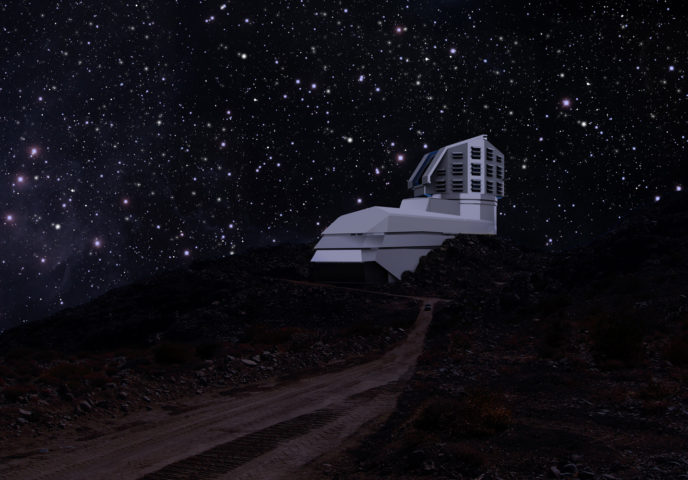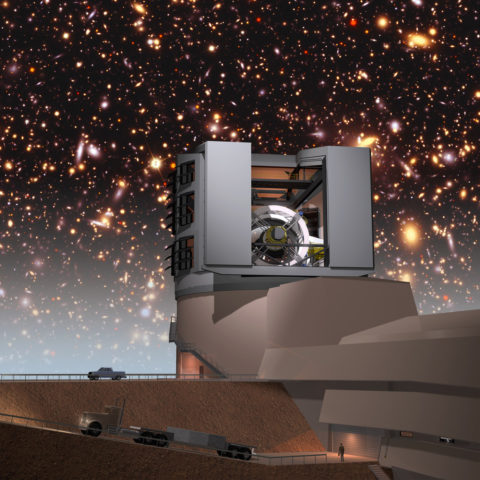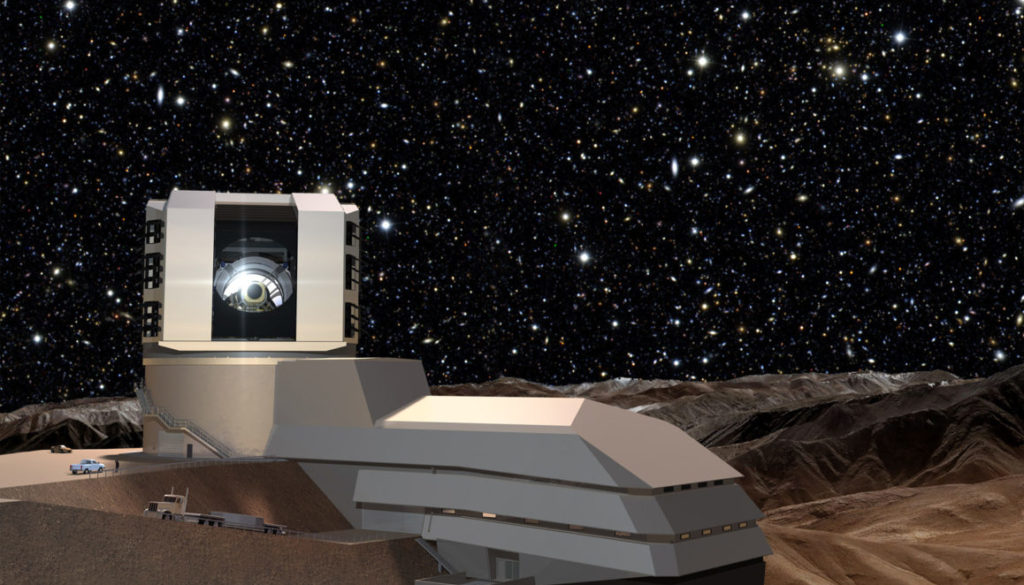AURA’s Large Synoptic Survey Telescope to Begin Construction, Thanks to National Science Foundation Funding Support
The National Science Foundation (NSF) has officially agreed to support the Association of Universities for Research in Astronomy (AURA) in managing the construction of the Large Synoptic Survey Telescope (LSST) in Chile.
Texas A&M University astronomers Nicholas B. Suntzeff, Lifan Wang and Lucas Macri in the George P. and Cynthia Woods Mitchell Institute for Fundamental Physics and Astronomy have been part of the LSST project since its inception and are interested in using the telescope for their supernovae-related research. In particular, Macri is a contributor to the LSST Science Book and a member of two LSST science working groups. In addition, the Munnerlyn Astronomical Instrumentation Laboratory, via Texas A&M astronomer Darren DePoy, is a longtime collaborator and contributor to the telescope’s instrumentation and related devices.
The decision, made by NSF on Friday (Aug. 1), marks the official federal start of the LSST project, the top-ranked major ground-based facility recommended by the National Research Council’s Astronomy and Astrophysics decadal survey committee in its 2010 report, New Worlds, New Horizons. It is being carried out as an NSF and Department of Energy (DOE) partnership, with NSF responsible for the telescope and site, education and outreach, and the data management system, and DOE providing the camera and related instrumentation. Both agencies expect to support post-construction operation of the observatory.


The NSF construction budget for LSST is not to exceed $473M. The DOE Camera fabrication budget, which will be baselined later this year, is estimated to be $165M. Operations costs will be around $40M per year for the 10-year survey.
With the approved start occurring now, LSST will see first light in 2019 and begin full science operations in 2022.
Friday’s action culminates more than 10 years of developing, planning and reviewing of the LSST concept — largely the work of the LSST Corporation (LSSTC), a non-profit consortium of universities including Texas A&M and other research institutions. Fabrication of the major mirror components is already underway, thanks to private funding received from the Charles and Lisa Simonyi Foundation for Arts and Sciences, Bill Gates and other individuals.
Receipt of federal construction funds allows major contracts to move forward, including those to build the telescope mount assembly, the figuring of the secondary mirror, the summit facility construction, the focal plane sensors and the camera lenses.
“This agreement is a tribute to the hard work of an exceptional team of highly skilled individuals, many of whom have dedicated more than a decade to bringing LSST to this point,” said LSST Project Manager Victor Krabbendam. “After a rigorous design and development phase, the project team is ready to get down and dirty and actually build this amazing facility.”
By digitally imaging the sky for a decade, the LSST will produce a petabyte-scale database enabling new paradigms of knowledge discovery for transformative STEM education, project officials note. LSST will address the most pressing questions in astronomy and physics, which are driving advances in big data science and computing. LSST is not “just another telescope;” rather, a truly unique discovery engine.
“The broad range of science enabled by the LSST survey will change our understanding of the dynamic universe on timescales ranging from its earliest moments after the Big Bang to the motions of asteroids in the solar system today,” said LSST Director Steven Kahn of Stanford University. “The open nature of our data products means that the public will have the opportunity to share in this exciting adventure along with the scientific community. The most exciting discoveries will probably be those we haven’t yet even envisioned!”
AURA President William Smith echoed Krabbendam’s and Kahn’s sentiments and also expressed his enthusiasm for AURA’s role in the project.
“AURA is proud to provide management for the construction of LSST, an activity clearly aligned with our mission to promote excellence in astronomical research by providing access to state-of-the-art facilities,” Smith said. “Joining the Space Telescope Science Institute, the National Solar Observatory, the National Optical Astronomy Observatory and the Gemini Telescope as AURA Centers, LSST is a new paradigm in ground-based astronomy that will revolutionize both our cosmic knowledge and the open and collaborative methods of acquiring that knowledge.”
LSST’s construction funding will be provided through NSF’s Major Research Equipment and Facilities (MREFC) account. LSST passed its NSF Final Design Review in December 2013; the National Science Board gave the NSF conditional approval to move the project to construction status in May 2014. On the DOE side, LSST received Critical Decision-1 approval (CD-1) in 2011 and also just received CD-3a approval, which allows the project to move forward with long-lead procurements. The CD-2 review will take place the first week in November, with approval expected shortly afterward, formally fixing the baseline budget for completion of the camera project. In addition, the Particle Physics Project Prioritization Panel (P5), an advisory subpanel of the High Energy Physics Advisory Panel (HEPAP), recommended last month that DOE move forward with LSST under all budget scenarios, even the most pessimistic.
Read more about the LSST and other large telescopes on the universal horizon — including the Giant Magellan Telescope, in which Texas A&M is a founding partner — in this recent Mother Nature Network feature article.
# # # # # # # # # #
About the Association of Universities for Research in Astronomy: AURA is a consortium of 39 US institutions and 6 international affiliates that operates world-class astronomical observatories. Its role is to establish, nurture and promote public observatories and facilities that advance innovative astronomical research. In addition, AURA is deeply committed to public and educational outreach, and to diversity throughout the astronomical and scientific workforce. AURA carries out its role through its astronomical facilities. For additional information, visit http://www.aura-astronomy.org.
About the Large Synoptic Survey Telescope: LSST project activities are supported through a partnership between the National Science Foundation (NSF) and the Department of Energy (DOE). NSF supports LSST through a Cooperative Agreement managed by the Association of Universities for Research in Astronomy (AURA). The DOE-funded effort is managed by the SLAC National Accelerator Laboratory (SLAC). Additional LSST funding comes from private donations, grants to universities, and in-kind support from institutional members of LSSTC. Learn more at lsst.org.
About Research at Texas A&M University: As one of the world’s leading research institutions, Texas A&M is in the vanguard in making significant contributions to the storehouse of knowledge, including that of science and technology. Research conducted at Texas A&M represents annual expenditures of more than $820 million. That research creates new knowledge that provides basic, fundamental and applied contributions resulting in many cases in economic benefits to the state, nation and world. To learn more, visit http://research.tamu.edu.
-aTm-
Contacts: Suzanne Jacoby, LSST Communications Manager, (520) 626-1195 or sjacoby@lsst.org; Shana K. Hutchins, Texas A&M Science Communications, (979) 862-1237 or shutchins@science.tamu.edu; or Nicholas B. Suntzeff, (979) 229-9597 or nsuntzeff@tamu.edu
The post AURA’s Large Synoptic Survey Telescope to Begin Construction, Thanks to National Science Foundation Funding Support appeared first on Texas A&M College of Science
